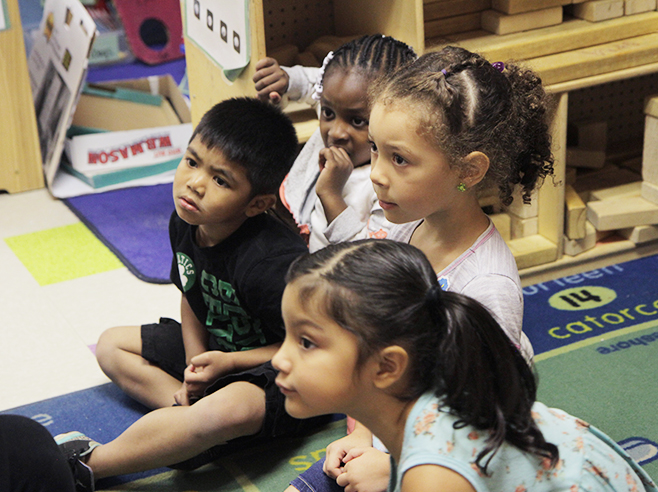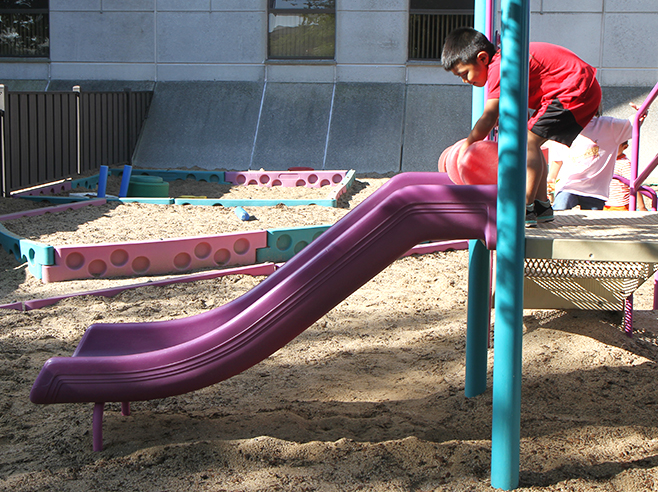Children go outside looking for ramps in their environment. Then they describe how the ramp makes a task easier for someone.
Materials

- Ball (such as a ping pong or tennis ball)
- Camera (iPad or cell phone)
- Optional: Projector
Preparation
- Prior to the activity, walk around your school grounds in search of ramps in your environment. For example, look for a slide, an angled rooftop, a hill, a curb cut, an accessibility ramp, a delivery truck ramp, and so on.
- Gather ramp hunt materials together to bring outside.
- Note: If you are unable to ramp hunt outdoors, look for ramps inside the school building.
Directions: Lessons 3
Outdoors
- Before heading outside, discuss what children know about ramps. Possible discussion ideas:
- What is a ramp? What does a ramp look like?
- Have you ever seen a ramp? Was anyone using the ramp? Describe how these ramps are being used. How are the ramps helping the people using them?
- Talk about how a ramp is used to help solve a problem. Offer examples to help children grasp how ramps help people, such as:
- A curb ramp can help a dad safely and smoothly move a stroller off the sidewalk. How?
- A moving truck ramp helps movers get large items that are on the truck down to the ground. How?
- Take children outside to hunt for ramps. Encourage them to use a ball to test whether a surface is a ramp. Explain that a ball will roll down a ramp on its own, but it will stay put on a flat surface until you or another force, like wind, moves it.
- Why do you think the ball rolls down a ramp on its own?
- While children are exploring, encourage them to discuss the ramps they find with other children. Possible discussion ideas:
- Why do you think that (slide) is a ramp?
- Do you think the (basketball court) is a ramp? Will the ball roll on its own when you put it on the basketball court? Let’s try it. Discuss the experiment results.
- How can this (curb) ramp make it easier for someone who is riding a bike?
- Take pictures of the ramps children find on their ramp hunt. If possible, include people using the ramp.
Circle Time: Wrap-Up
- Show the photos of ramps children found outside on the ramp hunt. If possible, project them on a wall or white screen so all children can see them easily.
- Ask children to describe each ramp and how it makes something easier for a person to do. Possible discussion ideas:
- Would it be easier for someone to ride a bike down a ramp or down a staircase? Why do you think that?
- Did you need to push the ball to make it roll down the slide? Why or why not?
- After finding ramps around our school, do you have any other ideas on where you might find ramps in your neighborhood?
- What questions do you still have about ramps and how they help people solve problems?
Directions: Lesson 4
Learning Center
- Invite children to review in pairs or individually the photos of ramps they found outside on the ramp hunt. Encourage them to look at each photo and observe how a person is using the ramp (if shown).
- Use prompts such as those above to engage children in a discussion about how ramps help people.
- Model language to describe how a ramp has an incline with one end higher than the other and how ramps help make a task easier for people.
- Encourage children to listen to and build on each other’s ideas.
Directions: Lesson 12
Outdoors
- Take children outside to hunt for ramps. Encourage them to use a ball to test whether a surface is a ramp. Explain that a ball will roll down a ramp on its own, but it will stay put on a flat surface until you or another force, like wind, moves it.
- Why do you think the ball rolls down a ramp on its own?
- While children are exploring, encourage them to discuss the ramps they find and how the ramps help someone do a task. Possible discussion ideas:
- How do you know the (curb cut) is a ramp? How does that help someone do a task? (roll a stroller, ride a bike, etc.)
- Do you think the (basketball court) is a ramp? What would happen in a basketball game if the court was a ramp? Discuss how the ball would roll away from the players.
- Take pictures of the ramps children find on their ramp hunt. If possible, include people using the ramp.


